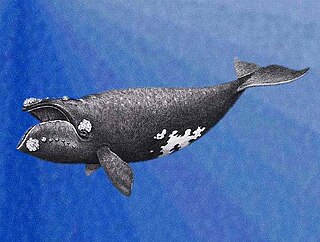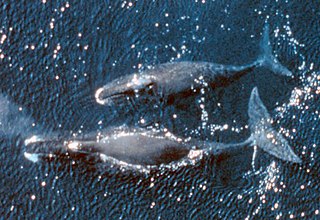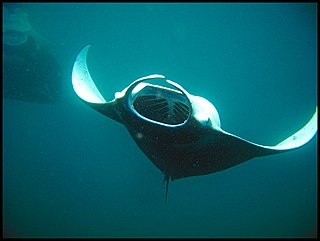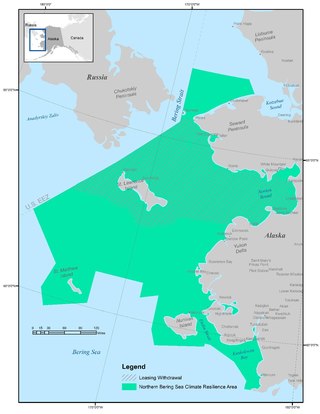Sue Moore | |
|---|---|
 | |
| Alma mater | University of California, San Diego |
| Scientific career | |
| Thesis | Cetacean habitats in the Alaskan Arctic (1997) |
Sue E. Moore is a scientist at the University of Washington known for her research on marine mammals in the Arctic.
Sue Moore | |
|---|---|
 | |
| Alma mater | University of California, San Diego |
| Scientific career | |
| Thesis | Cetacean habitats in the Alaskan Arctic (1997) |
Sue E. Moore is a scientist at the University of Washington known for her research on marine mammals in the Arctic.
Moore has a B.A. from the University of California, San Diego and an M.S. from San Diego State University. [1] She earned her Ph.D. from the University of California, San Diego / Scripps Institution of Oceanography in 1997 working on whales in the Arctic. [2] Moore worked at the National Oceanic and Atmospheric Administration (NOAA) for twenty years, [1] and was appointed director of the NOAA National Marine Mammal Laboratory in 2002. [3] Moore was a member of the United States' delegation to the International Whaling Commission. [3] As of 2021, Moore is a research scientist in the department of biology at the University of Washington. [4] On May 25, 2022, Moore was nominated by US President Joe Biden to be a member of the US Marine Mammal Commission. [5] The nomination was positively forwarded to the full Senate by the Senate Commerce, Science and Transportation Committee on December 7, 2022. [6] The nomination was confirmed by the full US Senate on December 22, 2022. [7]
Moore is known for her research tracking marine mammals in the Arctic, including bowhead whales, [8] fin whales, [9] and gray whales. [10] She has used acoustic instruments, or sound, to listen to multiple species of whales along the coast of Alaska, [11] [12] including a project attaching acoustic instruments to gliders and then tracking marine mammals. [13] She has linked changes in sea ice with the habitats used by bowhead whales [14] and defined patterns in marine mammal distributions that track climate change in the Arctic. [15] [16]
A list of additional publications and a biographical sketch are available on the website of the Center for Ecosystem Sentinels at the University of Washington, https://ecosystemsentinels.org/sue-moore/
In 2020, Moore was elected to the Washington State Academy of Sciences in recognition of her work in the Arctic. [4] In 2020, the International Arctic Science Committee awarded the IASC Medal for "exceptional and sustained contributions to the understanding of the Arctic" to Moore. [17]

The Bering Sea is a marginal sea of the Northern Pacific Ocean. It forms, along with the Bering Strait, the divide between the two largest landmasses on Earth: Eurasia and the Americas. It comprises a deep water basin, which then rises through a narrow slope into the shallower water above the continental shelves. The Bering Sea is named after Vitus Bering, a Danish navigator in Russian service, who, in 1728, was the first European to systematically explore it, sailing from the Pacific Ocean northward to the Arctic Ocean.

Marine mammals are aquatic mammals that rely on the ocean and other marine ecosystems for their existence. They include animals such as cetaceans, pinnipeds, sirenians, sea otters and polar bears. They are an informal group, unified only by their reliance on marine environments for feeding and survival.

The beluga whale is an Arctic and sub-Arctic cetacean. It is one of two members of the family Monodontidae, along with the narwhal, and the only member of the genus Delphinapterus. It is also known as the white whale, as it is the only cetacean to regularly occur with this colour; the sea canary, due to its high-pitched calls; and the melonhead, though that more commonly refers to the melon-headed whale, which is an oceanic dolphin.
The Thule or proto-Inuit were the ancestors of all modern Inuit. They developed in coastal Alaska by the year 1000 and expanded eastward across northern Canada, reaching Greenland by the 13th century. In the process, they replaced people of the earlier Dorset culture that had previously inhabited the region. The appellation "Thule" originates from the location of Thule in northwest Greenland, facing Canada, where the archaeological remains of the people were first found at Comer's Midden. The links between the Thule and the Inuit are biological, cultural, and linguistic.

The North Pacific right whale is a very large, thickset baleen whale species that is extremely rare and endangered.

The Chukchi Sea, sometimes referred to as the Chuuk Sea, Chukotsk Sea or the Sea of Chukotsk, is a marginal sea of the Arctic Ocean. It is bounded on the west by the Long Strait, off Wrangel Island, and in the east by Point Barrow, Alaska, beyond which lies the Beaufort Sea. The Bering Strait forms its southernmost limit and connects it to the Bering Sea and the Pacific Ocean. The principal port on the Chukchi Sea is Uelen in Russia. The International Date Line crosses the Chukchi Sea from northwest to southeast. It is displaced eastwards to avoid Wrangel Island as well as the Chukotka Autonomous Okrug on the Russian mainland.

Foxe Basin is a shallow oceanic basin north of Hudson Bay, in Nunavut, Canada, located between Baffin Island and the Melville Peninsula. For most of the year, it is blocked by sea ice and drift ice made up of multiple ice floes.

Cumberland Sound is an Arctic waterway in Qikiqtaaluk Region, Nunavut, Canada. It is a western arm of the Labrador Sea located between Baffin Island's Hall Peninsula and the Cumberland Peninsula. It is approximately 250 km (160 mi) long and 80 km (50 mi) wide. Other names are Cumberland Straits,Hogarth Sound, and Northumberland Inlet. Old Norse is ᚠᛁᛋᚦᚱᛁ ᚢᛒᚢᚴᚦᛁᛦ, fisþri ubukþiR.

The Chukchi Shelf or Chukchi Sea Shelf is the westernmost part of the continental shelf of the United States and the easternmost part of the continental shelf of Russia. In the west it merges with the Russian Siberian Shelf. Within this shelf, the 50-mile Chukchi Corridor acts as a passageway for one of the largest marine mammal migrations in the world.

The Fram Strait is the passage between Greenland and Svalbard, located roughly between 77°N and 81°N latitudes and centered on the prime meridian. The Greenland and Norwegian Seas lie south of Fram Strait, while the Nansen Basin of the Arctic Ocean lies to the north. Fram Strait is noted for being the only deep connection between the Arctic Ocean and the World Oceans. The dominant oceanographic features of the region are the West Spitsbergen Current on the east side of the strait and the East Greenland Current on the west.

The bowhead whale is a species of baleen whale belonging to the family Balaenidae and is the only living representative of the genus Balaena. It is the only baleen whale endemic to the Arctic and subarctic waters, and is named after its characteristic massive triangular skull, which it uses to break through Arctic ice. Other common names of the species included the Greenland right whale, Arctic whale, steeple-top, and polar whale.
Fiona McLaughlin is a senior Oceanographer, employed by Canada's Department of Fisheries and Oceans. McLaughlin joined government service in 1972. Since 1994 she has concentrated on the ecology of the Arctic Ocean.

A planktivore is an aquatic organism that feeds on planktonic food, including zooplankton and phytoplankton. Planktivorous organisms encompass a range of some of the planet's smallest to largest multicellular animals in both the present day and in the past billion years; basking sharks and copepods are just two examples of giant and microscopic organisms that feed upon plankton. Planktivory can be an important mechanism of top-down control that contributes to trophic cascades in aquatic and marine systems. There is a tremendous diversity of feeding strategies and behaviors that planktivores utilize to capture prey. Some planktivores utilize tides and currents to migrate between estuaries and coastal waters; other aquatic planktivores reside in lakes or reservoirs where diverse assemblages of plankton are present, or migrate vertically in the water column searching for prey. Planktivore populations can impact the abundance and community composition of planktonic species through their predation pressure, and planktivore migrations facilitate nutrient transport between benthic and pelagic habitats.

Barrow Canyon is a submarine canyon that straddles the boundary between the Beaufort and Chukchi seas. Compared to other nearby areas and the Canada Basin, the highly productive Barrow Canyon supports a diversity of marine animals and invertebrates.
Herald Shoal is a region of high benthic productivity on the Chukchi Sea shelf. It serves as rich foraging habitat for many species of marine mammals and birds.

The Northern Bering Sea Climate Resilience Area, encompassing 291,000 square kilometers, is a protected area within the Bering Sea, established by President Obama on December 9, 2016 by Executive Order 13754. It represents a hugely productive, high-latitude marine ecosystem and supports one of the largest seasonal marine mammal migrations in the world, including thousands of bowhead and beluga whales, hundreds of thousands of walruses and ice seals, and millions of migratory birds. Moreover, it is home to more than 40 tribes of coastal Yup’ik and Inupiaq peoples whose way of life has been linked with the marine environment for thousands of years.

The Bering Strait has become vulnerable to climatic changes, trans Arctic shipping, and resource exploitation. The Obama administration's Executive Order 13754 of December 9, 2016 defines a Northern Bering Sea Climate Resilience Area that gives protection to the indigenous coastal communities that rely on the strait for subsistence hunting, and the surrounding marine ecosystem's vitality. It exists within the U.S exclusive economic zone and within maritime boundaries agreed upon between the Soviet Union and the U.S. The ecosystem, civilization, and international trade all rely on each other, thus encouraging the establishment of the sensitive marine areas in the Bering Strait. The executive order was upheld by international climate goals, and environmental management standards. Since the location is of international interest, it became vital to protect this area from further exploitation in the oil and shipping industry.

Early on in his campaign for election, former president Barack Obama made it clear that climate change was a priority for his administration. Soon after becoming President Elect in November 2008, he reiterated this positing stating: “Now is the time to confront this challenge once and for all. Delay is no longer an option. Denial is no longer an acceptable response.” Contradictory to his 2008 campaign promises on the Offshore drilling debate, Obama felt obliged to open coastal areas off the Alaskan coast to exploratory assessments for oil and gas as a means to continue to stimulate economic growth. This decision in March 2010 was abruptly reversed in May 2010 after the catastrophic failure of the Deep Water Horizon drilling operation, which led to the six-month moratorium on deep water drilling in the United States territorial waters.
Jacqueline M. Grebmeier is an American ecologist who specializes in polar biological oceanography.
Kate Stafford is the Senior Principal Oceanographer in the Applied Physics Lab at the University of Washington and an affiliate Associate Professor in the School of Oceanography at the University of Washington in Seattle. She is also an Associate Professor and Principal Investigator at Oregon State University in the Marine Mammal Institute. Her research focuses on the changing acoustic landscape and the impacts of declining sea ice and human industrial influences affect Arctic marine mammals.